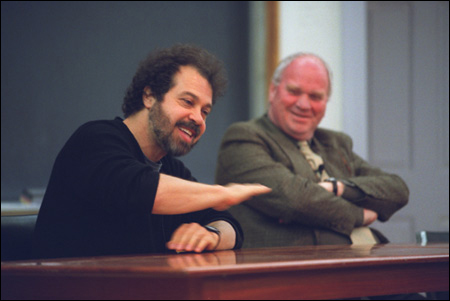Zwick ’74 premieres ‘Samurai in Cambridge
In theater and in class, filmmaker Ed Zwick explores the myth and reality of the samurai

For filmmaker Ed Zwick ’74, the premiere of his forthcoming film “The Last Samurai” at the Harvard Square Theater Sunday night (Nov. 9) completed a circle he began more than 30 years ago.
At the same theater (albeit in a different location) in 1971, a festival of the films of Akira Kurosawa – which included his masterful “The Seven Samurai” – sparked Zwick’s fascination with Japanese culture. “There’s a lovely irony to my being here tonight,” he told the audience of Harvard students and faculty invited by the Office for the Arts, which sponsored Zwick’s visit.
Visit the Web site for Zwick’s ‘The Last Samurai’
Zwick, who lists director, producer, and writer as his credits, has worked in television and film, grabbing those industry’s highest honors. He directed the Academy Award-winning films “Glory” and “Legends of the Fall,” and produced “Traffic” and “I Am Sam”; with his business partner Marshall Herskovitz he created the acclaimed television series “thirtysomething,” “My So-Called Life,” and “Once and Again.”
Like “Glory” and “Legends of the Fall,” “The Last Samurai” returns to the late 19th century and explores sweeping moral themes punctuated by vivid, bloody images of battle. Starring Tom Cruise and Ken Watanabe, the film’s thematic tension turns on the collision of Western European influences and traditional Japanese culture that marked the late 1900s in Japan. Cruise plays Capt. Nathan Algren, an American war hero who, in 1876, has descended to drink. He’s recruited by the emperor of Japan to train a modern army against the ancient samurai warriors, whose rebellion and tradition-bound ways stand in the path of Japan’s modern future.

Quickly captured by the samurai and their powerful, spiritual leader Katsumoto (Watanabe), Cruise, still haunted by his soulless slaughtering of Native Americans after the Civil War, slowly falls under their influence. He learns Japanese, trades his Western arms to master the samurai’s sword, and most importantly, adopts the honor that is at the core of the samurai ethic. In the film’s climax, Algren and Katsumoto lead the samurai, their arms and battle style more medieval than modern, against the emperor’s Western-trained and -armed forces for a finale both surprising and inevitable.
(De)constructing the samurai
Although “The Last Samurai” does not open in theaters until Dec. 5, Zwick faced some tough critics Monday morning (Nov. 10) in Professor of Japanese History Harold Bolitho’s “Constructing the Samurai” course, where he fielded questions for the entire class period. The Core course’s syllabus stands, in many ways, in direct opposition to Zwick’s film: It probes the mythology of the samurai and seeks to understand that it perhaps never existed in the way it’s remained in Japanese popular culture and Western imagination.
Zwick, casually dressed and affable, was unruffled as he teased apart the filmmaker’s craft from the academic’s search for truth. “The myths of a culture are sometimes as important as the history,” he said. “As dramatists, we are as interested in the iconography as we are in the individual truths.” Indeed, the “rugged individualist” idea of the American West as embodied by Capt. Algren never existed either, he said.
To a student’s question about the veracity of the story, Zwick responded that “all and none” of the story is true. Set in the Meiji Restoration, the film’s central struggle between Western modernization and the traditional culture of a long-isolated Japan stands on firm historical ground. Zwick took as a point of departure the story of Saigo Takamori, told in Ivan Morris’ book “The Nobility of Failure,” mining the story of Takamori’s support of – then rebellion against – the emperor.
Many details in the film are true to Japan’s history, he said, crediting the historians, other filmmakers, and even his translators with whom he consulted. “These extraordinary collaborators understood entirely what my intentions were and they made them their own,” he said. “They were bound and determined that I get it right.”
During the period in which the film is set, Zwick said, Western experts were indeed imported to school the Japanese on “modern” warfare, and the culture of the samurai was squelched with laws forbidding the wearing of swords in public and by the cutting off of samurai’ topknots, two details portrayed in the film. Zwick also called the details of the props, from swords to armor to fabric, “fabulously authentic.”
Zwick admitted that history sometimes took a backseat to drama, however. The ninja-like assassins that descend upon Algren and Katsumoto at one point serve the story exclusively, helping to forge a bond between the two former adversaries.
“I’m walking the razor’s edge here, of trying to create entertainment and trying to create historical fiction,” Zwick said. “Trying to compress so much history into two hours and 20 minutes, there are these Sophie’s choices I made all the time.”
The filmmaker’s craft
Zwick also gave students insight into the logistics and craft of filmmaking. While he ducked a question about the mechanics of creating the cast-of-thousands battle scenes, he shared other behind-the-scenes details. Filming in New Zealand meant negotiating visas, housing, translation, and dietary needs for the Japanese cast. He recruited between 600 and 700 extras by scouring kendo clubs, police forces, and other likely sources of martial arts experts. Still, he said, they logged long, repetitive hours with a fight director and choreographer. “They had to be taught to fight so they didn’t beat each other’s brains out,” he said.
And Cruise, whose character learns samurai-style combat in the film, had never held a sword prior to signing on to “The Last Samurai.” He trained for a year and a half, said Zwick, learning not only to look good wielding a sword but also to avoid injury in the several fight scenes he’s in.
Cruise also labored over his Japanese lines, leaning on his fellow cast members for help with the subtleties of the accent. Zwick said he took some license with Cruise’s language acquisition, acknowledging that Japanese likely takes longer to learn than the six or nine months in which Cruise’s character ascends to a conversational level.
Yet for all its Hollywood gloss and myth-making history, Zwick said “The Last Samurai” has been well received by the Japanese audiences who have seen a rougher version of it. Invoking his inspiration in Kurosawa, he noted that director borrowed freely from Western culture, telling the stories of Macbeth or King Lear as universal.
“I, perhaps idealistically, operated from that assumption,” he said, again crediting his Japanese collaborators for helping to keep the film’s integrity. “My many gaffes were responded to with great good humor and goodwill.”
In the end, it seems that Zwick’s story well told will triumph over – and perhaps still honor – historical accuracy. “We’re learning about how the traditional samurai image that’s persisted in literature is not especially truthful,” said Laura Cowen ’04, a student in Bolitho’s course who gave the film an emphatic thumbs-up. “Even learning that this stuff wasn’t true doesn’t mean I didn’t appreciate the movie. I loved it.”




